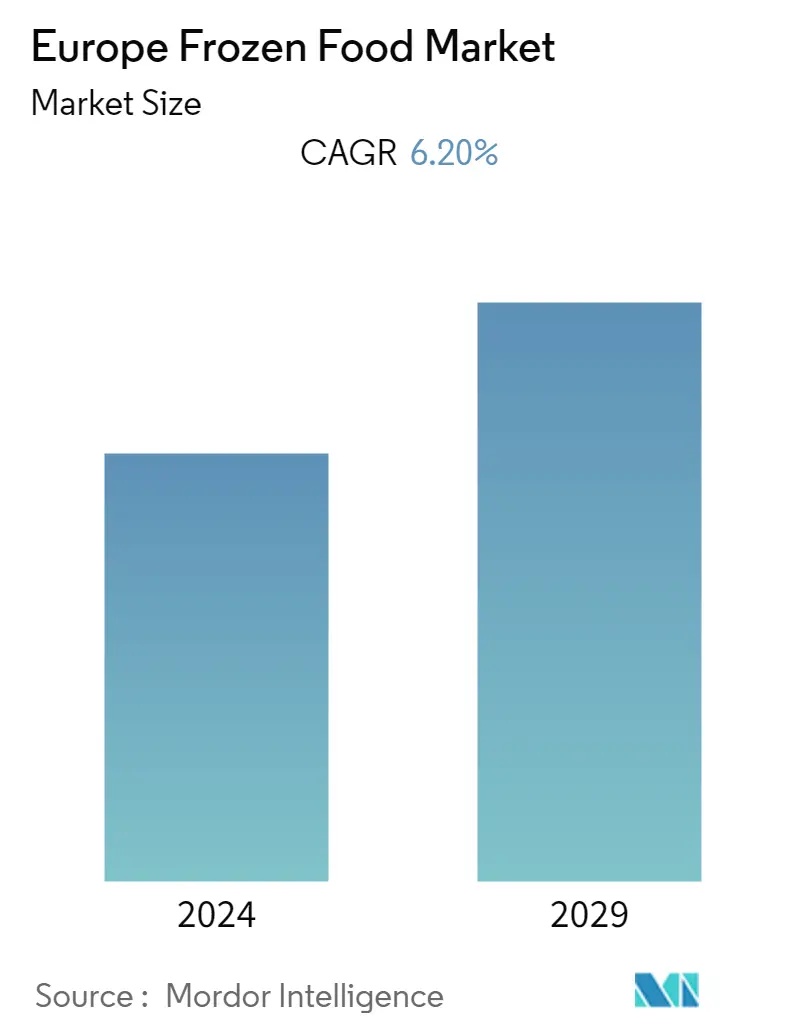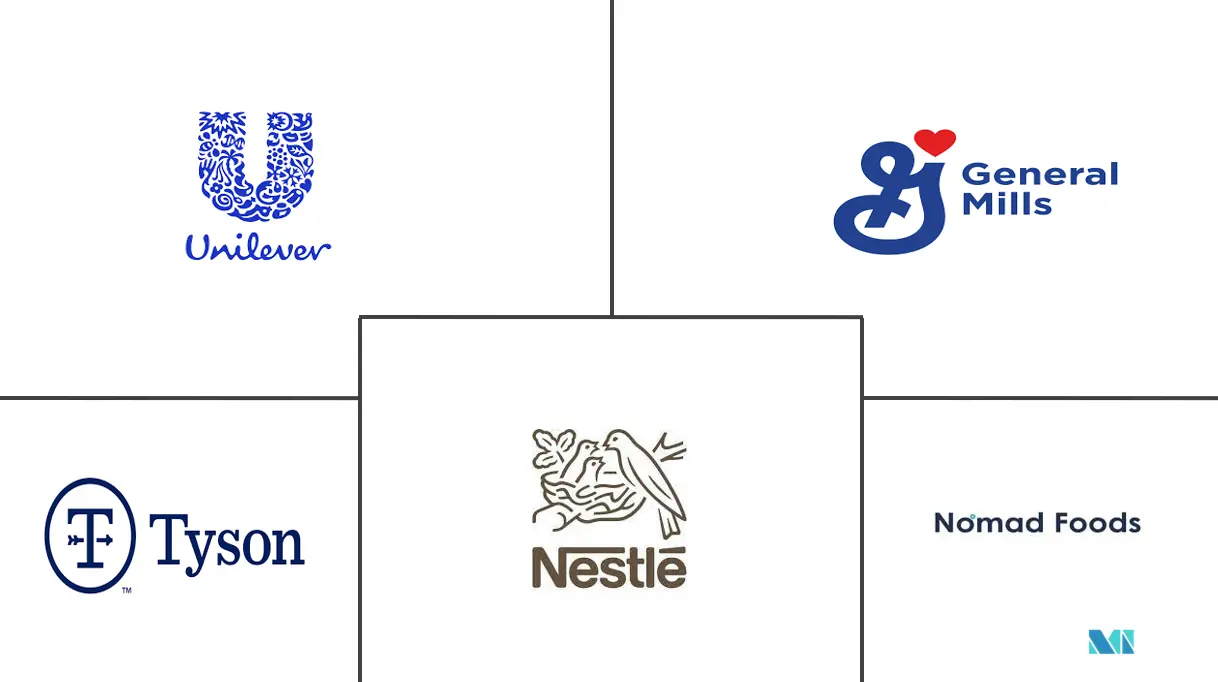Market Size of Europe Frozen Food Industry

| Study Period | 2018 - 2029 |
| Base Year For Estimation | 2023 |
| Forecast Data Period | 2024 - 2029 |
| Historical Data Period | 2018 - 2022 |
| CAGR | 6.20 % |
| Market Concentration | Low |
Major Players
*Disclaimer: Major Players sorted in no particular order |
Europe Frozen Food Market Analysis
The European frozen food market is projected to register a CAGR of 6.2% over the next five years.
The region has witnessed a growing demand for frozen foods in recent years, owing to the busy lifestyles, changing dietary habits, and increasing disposable income of households. The fast urbanization of certain countries, such as Germany, the Netherlands, and others, has increased the demand for convenience foods like frozen foods, as these can be prepared in less time and stored for a longer period. Additionally, the government's focus on reducing food waste is adding leverage to the frozen food market in some countries. According to a report by the European Commission, household food waste generated in 2020 averaged 31 kilograms per person, and "out-of-home" food waste totaled 0.75 kilograms per person. Most of this waste is produced during the distribution and consumption phases. Because frozen goods have such a long shelf life, they naturally decrease waste across the supply chain, in stores, and at the consumer level.
Moreover, eco-conscious consumers in the region are also interested in new trends in the frozen food market, like clean-label and plant-based frozen foods, owing to the rising veganism in the country. This, in turn, has led the manufacturers to strategize their product offerings to include plant-based food items for the emerging vegan consumer base. In line with this, in April 2021, Aviko and Eurofrits launched a joint venture, namely, NeWind Foods in Spain, to incorporate the production of plant-based frozen food for domestic as well as international consumers.
Europe Frozen Food Industry Segmentation
Frozen food products refer to packaged food that is subjected to rapid freezing and is kept frozen until used. The frozen food market in Europe is segmented by product category, product type, distribution channel, and geography. By product category, the market is bifurcated into ready-to-eat, ready-to-cook, and other product categories. By product type, the market is segmented into frozen fruits and vegetables, frozen meat and fish, frozen-cooked ready meals, frozen desserts, frozen snacks, and other product types. Based on distribution channels, the market is fragmented into supermarkets/hypermarkets, convenience stores, online channels, and other distribution channels. By geography, the market is segmented into Spain, Italy, the United Kingdom, Germany, France, Russia, and the Rest of Europe. For each segment, the market sizing and forecasts have been done on the basis of value (in USD million).
| By Products Category | |
| Ready-to-Eat | |
| Ready-to-Cook | |
| Other Product Categories |
| By Product Type | |
| Frozen Fruits and Vegetables | |
| Frozen Meat and Fish | |
| Frozen-cooked Ready Meals | |
| Frozen Desserts | |
| Frozen Snacks | |
| Other Product Types |
| By Distibution Channel | |
| Supermarkets/Hypermarkets | |
| Convenience Stores | |
| Online Stores | |
| Other Distribution Channels |
| By Geography | |
| Spain | |
| United Kingdom | |
| Germany | |
| France | |
| Italy | |
| Russia | |
| Rest of Europe |
Europe Frozen Food Market Size Summary
The European frozen food market is experiencing significant growth, driven by evolving consumer lifestyles and preferences. The increasing pace of urbanization and the demand for convenience foods are key factors propelling the market forward. Busy consumers, particularly in countries like Germany and the Netherlands, are opting for frozen foods due to their quick preparation and long shelf life, which align with the fast-paced modern lifestyle. Additionally, the focus on reducing food waste by governments and the eco-conscious shift towards clean-label and plant-based options are further influencing market dynamics. Companies are responding by diversifying their product offerings to include vegan and plant-based frozen foods, catering to the growing demand from environmentally aware consumers.
The competitive landscape of the European frozen food market is marked by the presence of both global and regional players, which intensifies the competition. Key industry players are leveraging product innovation and strategic expansions to maintain and enhance their market positions. The market is also witnessing a rise in demand for frozen snacks and meals, supported by the availability of affordable and healthy options with extended shelf lives. This trend is particularly evident in the United Kingdom, where families and younger consumers are increasingly choosing frozen foods. Companies are focusing on child-centric products and health-conscious alternatives to meet the evolving consumer preferences. The market's growth is further supported by the expansion of distribution channels, both online and offline, allowing brands to reach a broader audience.
Europe Frozen Food Market Size - Table of Contents
-
1. MARKET DYNAMICS
-
1.1 Market Drivers
-
1.2 Market Restraints
-
1.3 Porter's Five Force Analysis
-
1.3.1 Threat of New Entrants
-
1.3.2 Bargaining Power of Buyers/Consumers
-
1.3.3 Bargaining Power of Suppliers
-
1.3.4 Threat of Substitute Products
-
1.3.5 Intensity of Competitive Rivalry
-
-
-
2. MARKET SEGMENTATION
-
2.1 By Products Category
-
2.1.1 Ready-to-Eat
-
2.1.2 Ready-to-Cook
-
2.1.3 Other Product Categories
-
-
2.2 By Product Type
-
2.2.1 Frozen Fruits and Vegetables
-
2.2.2 Frozen Meat and Fish
-
2.2.3 Frozen-cooked Ready Meals
-
2.2.4 Frozen Desserts
-
2.2.5 Frozen Snacks
-
2.2.6 Other Product Types
-
-
2.3 By Distibution Channel
-
2.3.1 Supermarkets/Hypermarkets
-
2.3.2 Convenience Stores
-
2.3.3 Online Stores
-
2.3.4 Other Distribution Channels
-
-
2.4 By Geography
-
2.4.1 Spain
-
2.4.2 United Kingdom
-
2.4.3 Germany
-
2.4.4 France
-
2.4.5 Italy
-
2.4.6 Russia
-
2.4.7 Rest of Europe
-
-
Europe Frozen Food Market Size FAQs
What is the current Europe Frozen Food Market size?
The Europe Frozen Food Market is projected to register a CAGR of 6.20% during the forecast period (2024-2029)
Who are the key players in Europe Frozen Food Market?
Tyson Foods, Inc., Nestle SA, Unilever PLC, General Mills Inc. and Nomad Foods Europe Limited are the major companies operating in the Europe Frozen Food Market.

